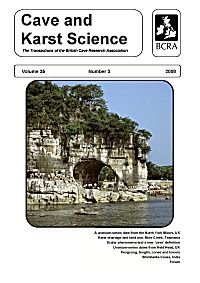- The most recent issue to be published was 52(2)
- For further information, please see Publishing/Despatch Schedule
- Database last updated on Sun, 12 Oct 2025 11:27:23 +0100
Open Access to C&KS: From Volume 51(1) (April 2024) all individual papers in C&KS will be Open Access, although some additional content
(e.g. supplements) might still require a login. Open Access means that you will not need to log in to download a paper. Open Access is indicated by the open padlock icon
next to each listing. Issues of C&KS published before 2024
(i.e. volume 50 and earlier) continue to require a login, which is free. BCRA members may apply for a free online id, and all visitors to these pages are offered
the option of a monthly free login when they try to download any protected content.
Contents of Cave & Karst Science 35(3)
This page may take a few seconds
to load. Please wait ...
- Cave and Karst Science (iv + 48pp)
(PDF 6.2MB)
  Individual articles may be available below Individual articles may be available below
- GUNN, John and David LOWE (eds.). (2008). Cave and Karst Science
35(3).
Buxton: British Cave Research Association.
ISSN 1356-191X. iv + 48pp, A4, with photos, maps and diagrams.
This issue has a cover date of 2008 (December) and was published in January 2010.
- The Transactions of the British Cave Research Association
- Layman's Summaries
-
Some of the articles in this issue are explained in a layman's summary.
Look for the 'Summary' icons below, or download the article from here:
PDF 939KB
 
- Front cover photo (page i)
(PDF 246KB)

- by Tony WALTHAM.
A splendid piece of phreatic tube at Guilin, China, truncated by the Li River and now isolated in a modest remnant tower. The site is known as Elephant Trunk Hill (Xiangbi Shan) after its passing resemblance to a drinking elephant when seen from the more frequently visited viewpoint on the other side. The cave is a relict of an ancient and undated drainage system that developed before surface lowering intersected it while the karst evolved into the fine fenglin that now surrounds Guilin. Photograph by Tony Waltham.
-
- Notes for Contributors (page ii)
(PDF 109KB)

-
- Contents (p73)
(PDF 98KB)

-
- Corrigenda to Vol 35(1&2) (p74)
(PDF 131KB)

-
- Editorial (p75)
(PDF 96KB)

- by Dave LOWE and John GUNN.
-
- Jack Myers leaves BCRA a substantial bequest (p76)
(PDF 93KB)

- by David CHECKLEY.
-
- Fengcong, fenglin, cone karst and tower karst (pp77-88)
(PDF 2.0MB)

- by Tony WALTHAM.
Fengcong and fenglin are the two major types of karst terrain as defined in Chinese literature. They correlate only loosely with the Western terms of cone and tower karst respectively. With its isolated towers rising from a karst plain, fenglin is the most extreme form of karst landscape, and much of it may evolve from fengcong where tectonic uplift is critically slow, but overall it appears to be polygenetic. It is suggested that fengcong and fenglin are more useful karst terms with genetic implications and should take precedence, whereas cones and towers should be used purely as descriptive terms.
Summary: For layman's summary see
PDF 939KB  
Classification: Paper.
Date: Received 16 March 09; Accepted 19 October 09.
- Bibliograph: WALTHAM, Tony. (2008). Fengcong, fenglin, cone karst and tower karst. Cave and Karst Science 35(3), (pp77-88).
-
- Size matters: scalar phenomena and a proposal for an ecological definition of 'cave (pp89-94)
(PDF 970KB)

- by Max MOSELEY.
Caves, as ecological units, are redefined in terms of the ecologically-significant scalar phenomena that, in contrast with such traditional criteria as perpetual darkness, environmental stability and oligotrophy, are the special characteristics of large cavities (macrocaverns) in rocks. When so defined, 'caves' are ecologically distinct from the mesocaverns and all other subterranean habitats. Some implications of this perspective for the ecological classification of animals found in subterranean habitats are briefly discussed.
Summary: For layman's summary see
PDF 939KB  
Classification: Paper.
Date: Received 10 July 09; Accepted 12 September 09.
Keywords: caves, scalar phenomena, macrocaverns, mesocaverns, communities, terminology.
- Bibliograph: MOSELEY, Max. (2008). Size matters: scalar phenomena and a proposal for an ecological definition of 'cave. Cave and Karst Science 35(3), (pp89-94).
-
- Karst drainage relations with catchment land use change, Mole Creek, Tasmania, Australia (pp95-104)
(PDF 996KB)

- by Deborah L HUNTER, Trevor W LEWIS and Joanna ELLISON.
Since 2001, the previously perennial Parsons' Spring of the Mole Creek fluviokarst in northwestern Tasmania, Australia, has become intermittent in discharge. This change follows the establishment of 636 ha of eucalypt plantations since 1995 above the Spring, including where Quaternary slope deposits obscure the geological contact of the limestone with overlying rocks. In this 2008 study, water quality was compared and contrasted between Parsons' Spring and other sites in the study catchment and a resurgence in a nearby reference catchment over different flow conditions and in response to a rainstorm. Results show that the study spring has a mixed recharge regime and complex discharge controls, including diffuse and conduit hydrological components. Parsons' Spring is probably the main wet season overflow spring of a distributary system connected to the phreatic aquifer underlying the area. Apparent chemical 'signatures' indicating soil disturbance in the study spring's waters implied the presence of an epikarst reservoir beneath the slope deposits cultivated for plantation establishment. Given their location, extent and growth stage, the plantations are expected to reduce aquifer recharge substantially by 2013-2018 as interception of recharge increases. The consequent reduction of available aquifer yield would result in economic stress for the rural community and compromise of karst ecosystems. (This paper was first presented audio-visually at a conference of the Australian Speleological Federation in January 2009, and a shorter version has been submitted for the conference proceedings).
Summary: For layman's summary see
PDF 939KB  
Classification: Paper.
Date: Received 14 January 09; Accepted 20 September 09.
- Bibliograph: HUNTER, Deborah L; Trevor W LEWIS and Joanna ELLISON. (2008). Karst drainage relations with catchment land use change, Mole Creek, Tasmania, Australia. Cave and Karst Science 35(3), (pp95-104).
-
- A uranium-series date from a karst cave on the North York Moors, Yorkshire, UK (pp105-106)
(PDF 162KB)

- by Phillip J MURPHY and David J LOWE.
Summary: For layman's summary see
PDF 939KB  
Classification: Report.
Date: Received 02 September 09; Accepted 08 October 09.
- Bibliograph: MURPHY, Phillip J and David J LOWE. (2008). A uranium-series date from a karst cave on the North York Moors, Yorkshire, UK. Cave and Karst Science 35(3), (pp105-106).
-
- Bhimbetka Caves, Madhya Pradesh, India (pp107-110)
(PDF 939KB)

- by Tony WALTHAM.
The Bhimbetka Hills in central India are made of Precambrian quartzitic sandstone and contain hundreds of small caves and rock shelters, with origins similar to those of other caves in quartzite. The caves are also notable for their wealth of Palaeolithic and Mesolithic paintings.
Summary: For layman's summary see
PDF 939KB  
Classification: Report.
Date: Received 25 April 09; Accepted 29 May 09.
Keywords: cave, sandstone, paintings, India.
- Bibliograph: WALTHAM, Tony. (2008). Bhimbetka Caves, Madhya Pradesh, India. Cave and Karst Science 35(3), (pp107-110).
-
- New uranium-series dates from Keld Head, Kingsdale, North Yorkshire, UK (pp111-114)
(PDF 1020KB)

- by Phil MURPHY, John CORDINGLEY and Tony WALTHAM.
Dated stalagmite flowstone from the underwater passages in Keld Head indicates that the cave was partially drained about 89,000 years ago. This implies that the cave was draining into a Kingsdale valley that had a lower floor profile prior to deposition of the Raven Ray moraine and subsequent alluviation of the main valley floor.
Summary: For layman's summary see
PDF 939KB  
Classification: Report.
Date: Received 09 September 09; Accepted 16 September 09.
Keywords: Kingsdale, stalagmite, uranium-series dates, glaciation, alluviation.
- Bibliograph: MURPHY, Phil; John CORDINGLEY and Tony WALTHAM. (2008). New uranium-series dates from Keld Head, Kingsdale, North Yorkshire, UK. Cave and Karst Science 35(3), (pp111-114).
-
- Abstracts Of the 20th BCRA Cave Science Symposium, University of Sheffield, 7 March 2009, and Field Meeting, Creswell Crags, 8 March 2009 (pp115-120)
(PDF 174KB)

- Classification: Forum.
-
- Book Review (p120)
(PDF 109KB)

- Hydromythology and the ancient Greek world, an earth science perspective emphasizing karst hydrology, by Cindy Clendenon. Published by Fineline Science Press, Lansing, Michigan. 2009. xvii + 502 pp. 7 maps. Soft back. ISBN 978-0-9818421-0-3. Price US $ 32.95.
Classification: Forum.
-
- Research Fund and Grants (page iii)
(PDF 101KB)

-
- Back cover photos (page iv)
(PDF 453KB)

- by Tony WALTHAM.
A montage of images from the splendid karst around Guilin and Yangshuo in Guangxi, China. Photographs by Tony Waltham.
-

| Please ignore this information box: we are doing some maintenance
work today.
remote: Array
(
)
local:
|
|

View Contents:

BCRA is a UK registered charity and is a constituent body of
the British Caving Association,
undertaking charitable activities on behalf of the BCA.
BCRA publishes a range of periodicals and books.
Click here for further information.
|
Searching
To Search our pages using Google, type a search
string in the box at the top of the page and hit your Return key
You can also search our publications catalogue at the British Caving Library
The CREG Journal Search Engine is a new, powerful search engine which will, sometime, be extended
to cover Cave & Karst Science. We have a keyword search facility on our Cave Science Indexes pages but this may be rather out-of-date.
|
For staff use: Link to Database
Show/Hide
download figures next to each item (if available and non-zero; you might need to refresh page first). Counters last
reset on Thu 03-Jan-2019 17:29:28 +00:00. The figures are non-unique
click-throughs.
|








